Crop Yields Have Increased Dramatically in Recent Decades, But Crops Like Maize Would Have Improved More Without Climate Change
Climate change has slowed the productivity of key crops such as maize and soybeans, but might have had small positive impacts on wheat.
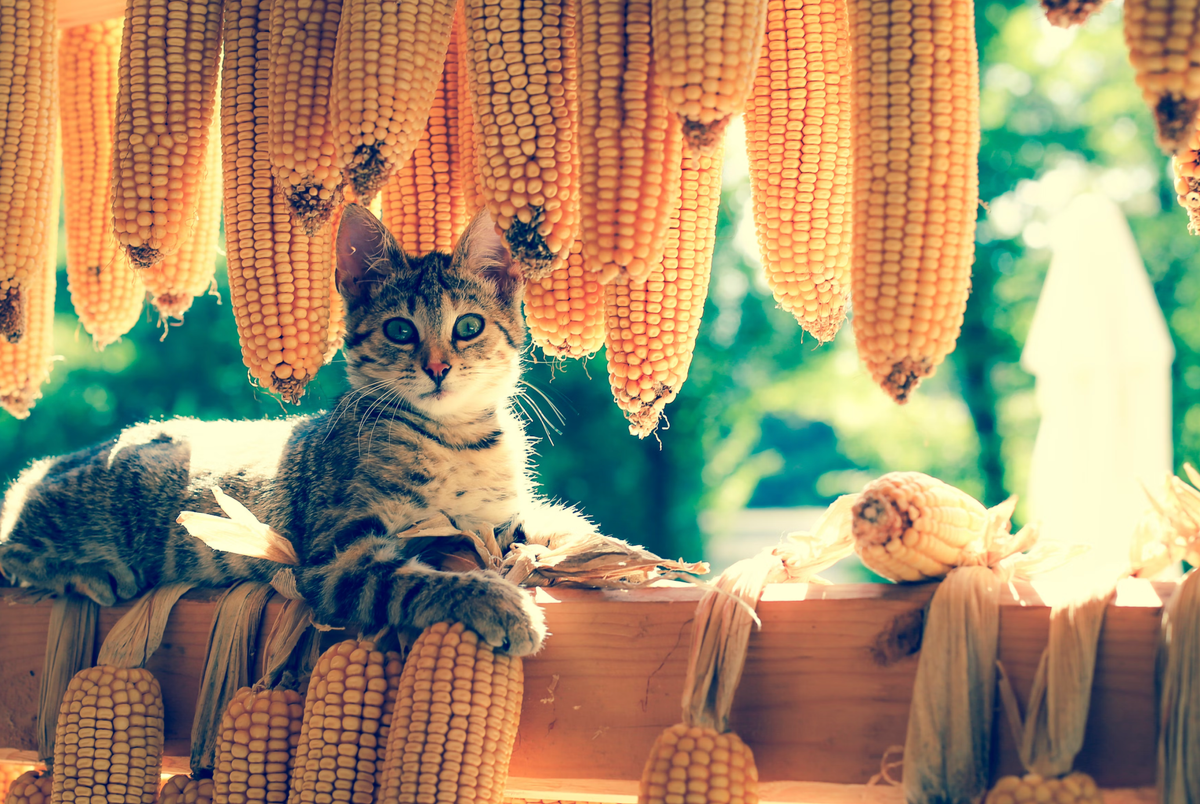
This article by Hannah Ritchie originally appeared in Our World in Data. Minor changes have been made to formatting and images.
Climate change has slowed the productivity of key crops such as maize and soybeans, but might have had small positive impacts on wheat.
Agriculture is arguably the industry most sensitive to changes in the climate. Crops need CO2, water — not too little or too much — and the right temperatures to grow. That’s why it’s the impact of climate change that I’m most worried about.
In this 3-part series on climate change and food, I’m going to look at three important questions: how has climate change already affected food production; what could these impacts look like in the future; and how can we feed a growing population in a warmer world?
In this first article, I’ll focus on the first question, looking at how different factors affect plant growth and how large these effects have already been.
How do CO2, temperature, and water impact crop yields?
You might have heard people argue over whether climate change would help or hurt crop yields.
Some argue that having more CO2 in the atmosphere is good because it increases plant growth, while others argue that higher temperatures reduce growth. Both are true at the same time. The combined impacts on yields vary a lot depending on the type of crop and location.
When considering the net impacts of climate on food production, we need to consider three key factors: higher concentrations of CO2, warmer temperatures, and changes in rainfall (which can cause too much, or not enough, water).1
Let’s look at each of these effects in isolation.
The first climate impact: carbon dioxide fertilisation
Carbon dioxide helps plants grow in two ways.2
First, it increases the rate of photosynthesis. Plants use sunlight to create sugars out of CO2 and water. When there’s more CO2 in the atmosphere, this process can go faster.
Second, it means plants can use water more efficiently. When there’s more CO2in the atmosphere, the pores on the surface of the leaves that release water can close slightly, allowing them to take in the same amount of CO2 while losing less water.
Both have a positive impact, CO2 does help plant growth.
But, some crops benefit much more than others. Wheat and rice benefit quite a lot. Maize, millet, and sorghum benefit much less, and only when under water stress conditions. The chart below shows the results of a large review of studies assessing how higher concentrations of CO2 impact crop yields.3 Here, CO2 concentrations were increased from 350 to 570 parts per million (ppm). For context, we’re currently at around 420 ppm, and reaching 570 ppm would mean global temperatures are 2°C to 2.5°C higher than pre-industrial times.
Wheat and rice yields increased by around 15% to 20%. Yields of maize and sorghum responded very little to CO2 under “normal” conditions but increased by 30% under water stress.
While non-cereal crops weren’t included in this review, other studies suggest that crops such as soybeans, potatoes, tomatoes, and other vegetables get large yield benefits from higher CO2 levels.4 Doubling levels of CO2 increased soybean yields by 22% to 45%; potato by 51%; lettuce by 35% to 44%; and tomato by around one-quarter.
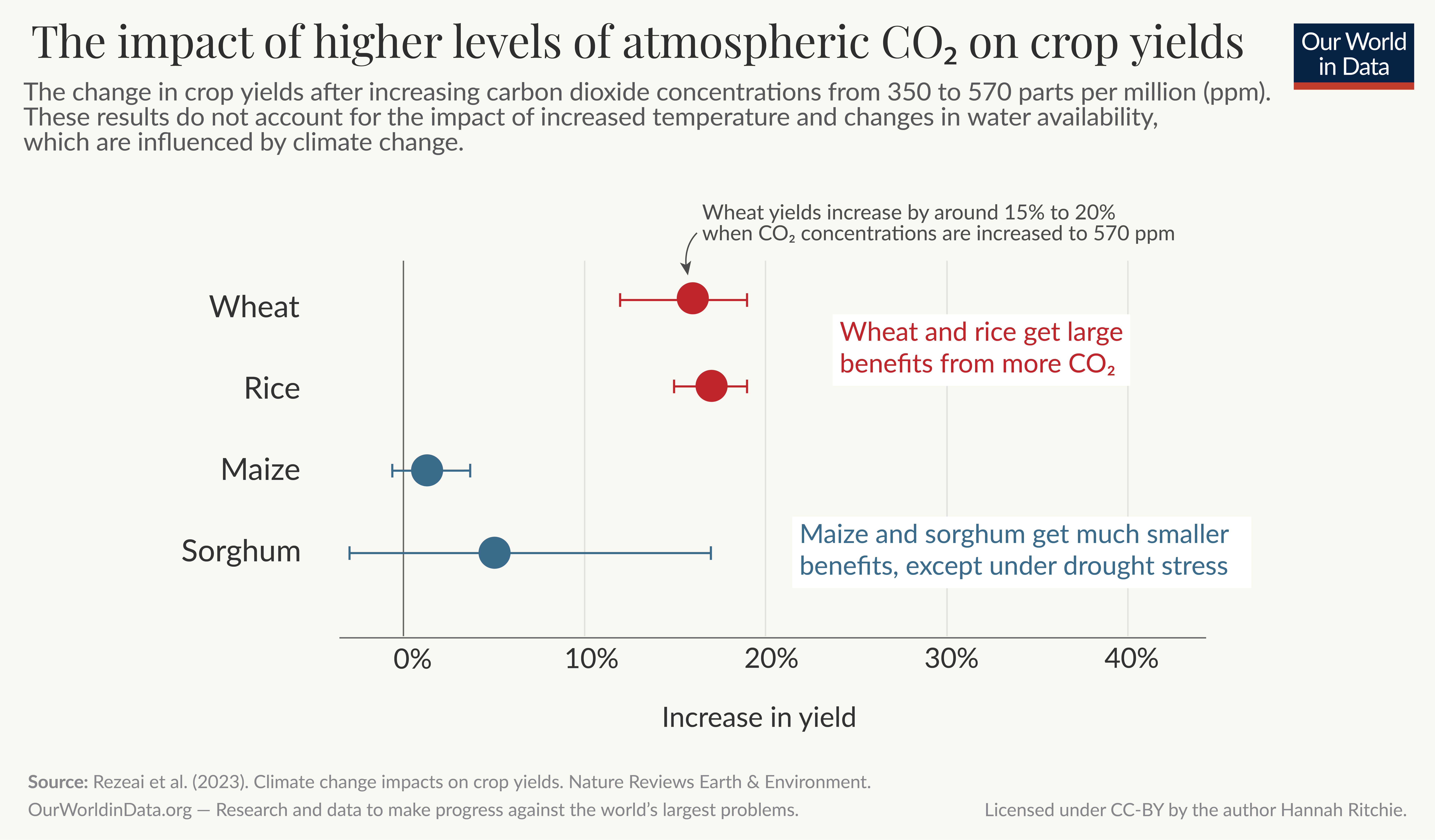
The second climate impact: warmer temperatures
Warmer temperatures can both benefit or hurt crop yields.5 There are a few reasons for this.
Warmer temperatures can increase the length of the potential growing season (sometimes called the “climatological growing season”).6 Crops have a minimum temperature below which they can’t be grown. The “growing season” is, therefore, often defined as the number of days across the year where mean temperatures are higher than this. For example, temperatures of 5°C or more are needed to grow winter or spring wheat.7 At high latitudes, warming will increase the number of days across the year when wheat can be planted, making the potential growing season longer.
At the same time, higher temperatures mean that crops mature faster, so their individual “growing period” is shorter.
Whether these changes positively or negatively impact productivity across the year depends on the type of crop, where it’s grown, and how farmers respond. Farmers could, for example, switch to “early-maturing” crop varieties so they can replant and produce a second harvest within a single year (also known as “double-cropping”).
Currently, temperature-limited regions — such as Northern Europe, Canada, and Russia — can potentially benefit from some warming, whereas tropical regions largely face losses.
Crops can grow at various temperatures, but each crop variety has an “optimum” temperature where they grow best. If temperatures are below or above the “optimum” temperature, crops grow more slowly and produce smaller grain seeds. Even brief exposure to extreme warm or cold temperatures (such as a heatwave or cold snap) can damage the plant tissue and kill the crop completely.
I’ve shown this in the schematic below, which shows how crop growth varies by temperature.
Each crop can grow across a range of temperatures and will have a slightly different curve. Crops like maize, millet, and sorghum tend to grow best at higher temperatures — reaching their optimum growth at 25°C to 30°C for maize and more than 30°C for millet and sorghum.
Wheat grows much better at lower temperatures of around 15°C to 20°C.
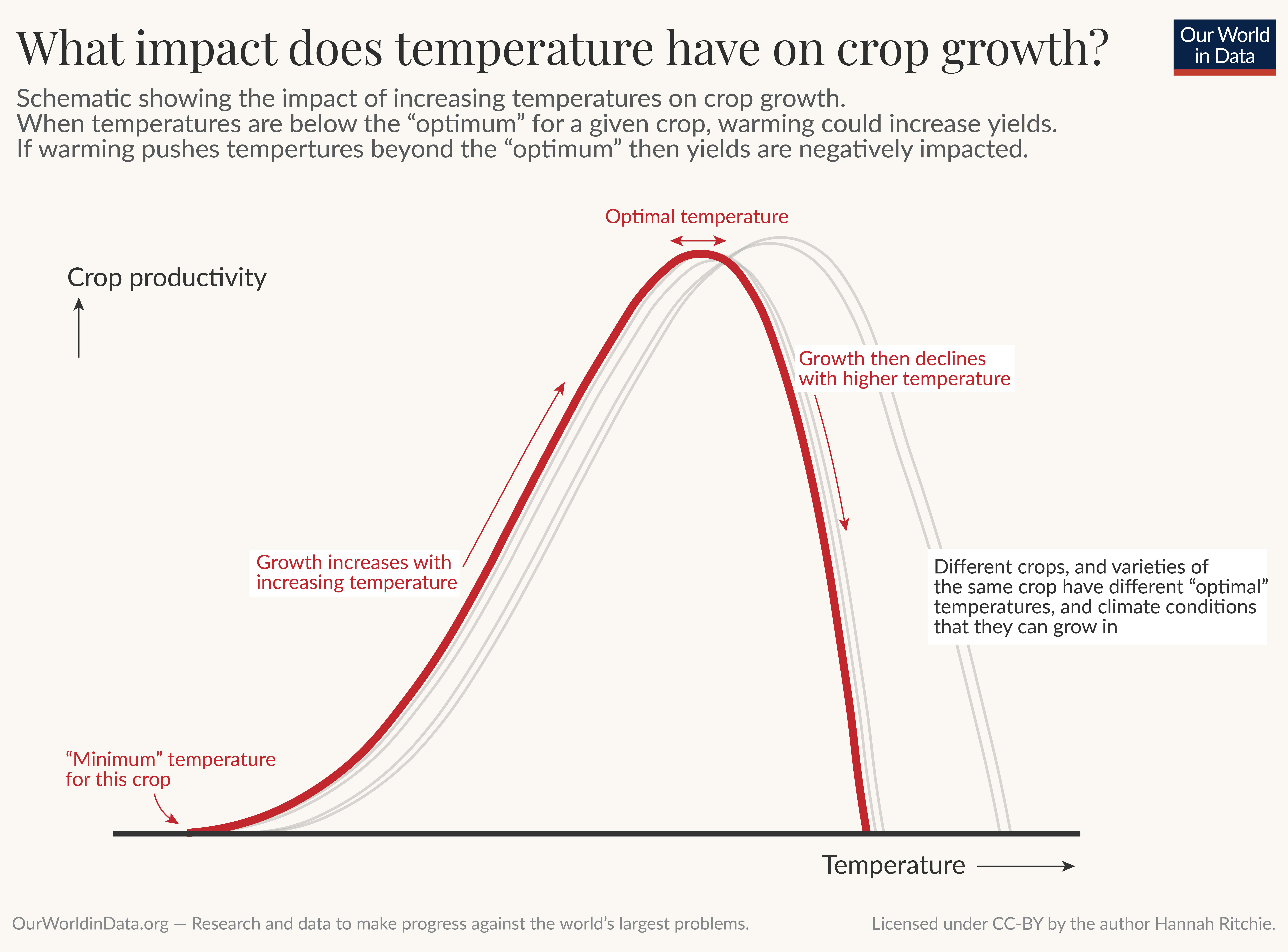
This explains where crops are grown across the world today. Europe produces lots of wheat, but very little maize. Millet is mostly grown across Sub-Saharan Africa and South Asia, where temperatures are higher. Sorghum, too.
How warmer temperatures will affect crop yields, therefore, depends on the choice of crop variety and how far a region’s temperature is away from the optimum. If the local temperatures are currently colder than the optimum, warming could increase yields. If temperatures are higher than is optimal, more warming will reduce them.
The third climate impact: water availability
Plants need water to grow and, therefore, struggle under water stress. But having too much water is also a problem. Too little water hampers photosynthesis, and the plant can even die; waterlogged soils, on the other hand, reduce the amount of oxygen available to the crop roots, which reduces plant growth.8
Changing rainfall patterns means crops could experience more frequent or intense drought or excess water.
How much does water availability impact crop yields?
The data in the chart below comes from a meta-analysis of tens to hundreds of experiments on different crops.3 It gives us some indication of the size of these impacts, but this can vary a lot depending on the crop type and local context.
The first panel in the chart below shows the reduction in yields that different crops experience under drought conditions. The average reduction in water availability was around 40% to 50%, but as I mentioned, this can vary a lot depending on the context.
Wheat tends to be much more tolerant of water stress than crops like maize, so it experiences lower yield declines under drought.
The second panel shows how yields are affected by waterlogging. Wheat and maize yields drop by 25% to 35%. Sorghum by more than 40%, on average.
Notice that rice isn’t shown here because it’s usually grown in water-logged paddies anyway.
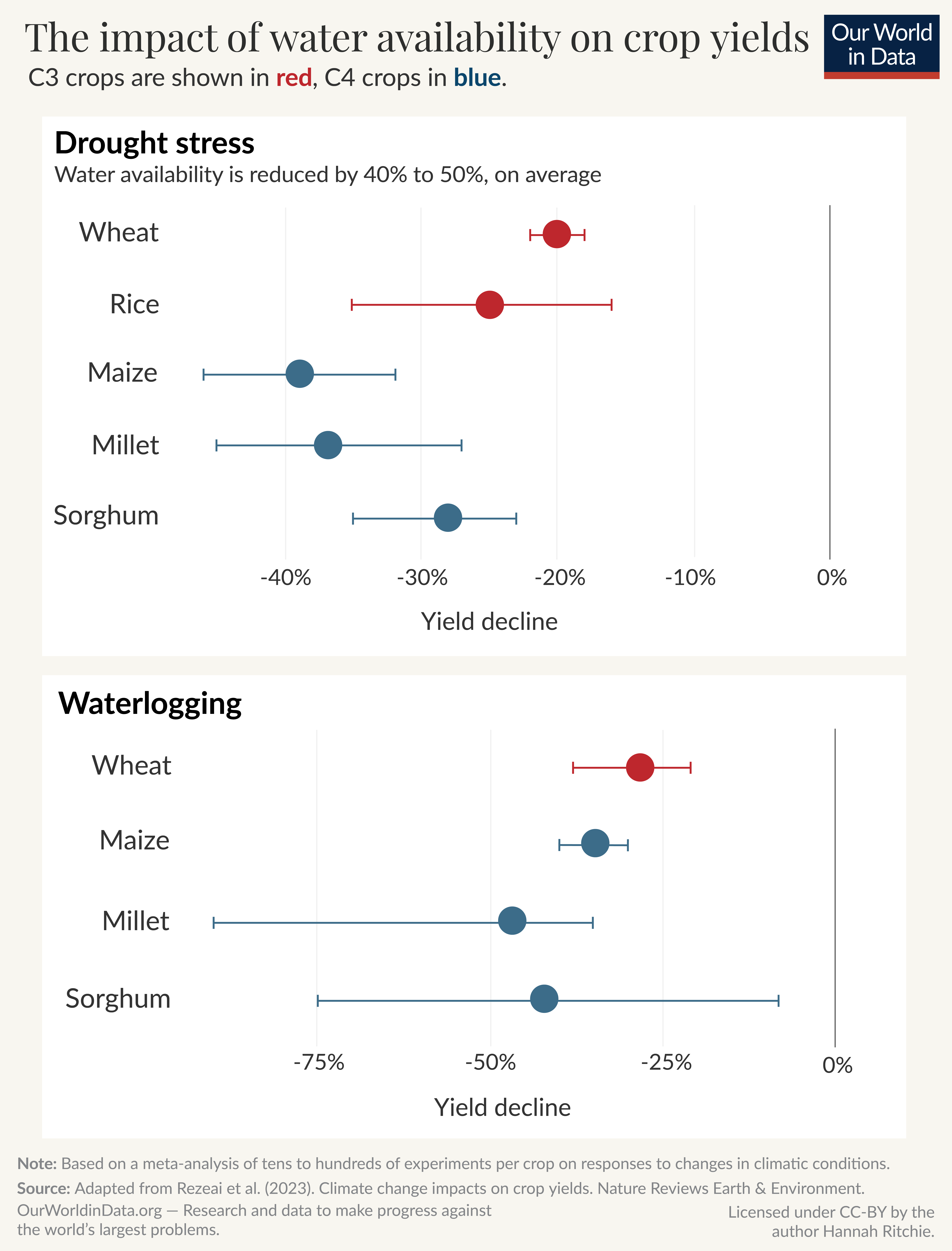
Taking all three effects together
In the real world, all three impacts come together. Atmospheric CO2 levels are rising and the world is getting warmer and rainfall patterns are changing.
Again, how these effects interact will depend on the crop type, how it is managed, and where it’s being grown. If a crop is under irrigation, for example, water stress is less of a concern.
For example, wheat harvests in Northern Europe could increase with climate change. Wheat benefits from higher levels of CO2, and since temperatures are often below the “optimum” for wheat, warming could push them closer to it.
That isn’t necessarily the case in Southern Europe. It’ll still benefit from carbon fertilization, but warming might push temperatures further away from the “optimum”. The losses from higher temperatures might offset the gains from having more CO2. The net effect will depend on how much the world warms, and how high CO2 concentrations are.
Maize production in the tropics and subtropics is different again. More CO2doesn’t benefit it much, and temperatures are already warmer than optimal, so more warming will hurt yields even more. The exception is under drought conditions when more CO2 could unlock semi-arid areas for agriculture because plants can use water more efficiently.
One important point is that climate and crop models mostly capture the averageeffects that CO2, temperature, and water availability have on crop yields. Even if the average changes are small, there could be a higher frequency of extreme events like heatwaves or droughts that lead to more variability from year to year.
In my next article, I’ll look at some concrete projections — by crop and by country — for how crop yields could change in the future. For now, the important takeaway is that the impacts differ between regions.
How has climate change already impacted crop yields?
The world has already warmed by around 1.3°C compared to pre-industrial temperatures. Atmospheric concentrations of CO2 have increased from around 280 to 420 ppm. What was the impact on crop yields and food production?
A large number of studies investigate the impact of increased temperatures, changes in water availability, or CO2 concentrations individually, but a much smaller number of studies combine all three.9
Those that do — including those cited in the latest AR6 report from the Intergovernmental Panel on Climate Change (IPCC) — report mixed results.10
A study from Frances Moore found that the impacts of increased temperatures alone harmed the yields of three staple crops, but the drop “has likely been fully compensated, at a global level, by gains from CO2 fertilization”.11 In other words, the combined effect of these variables was probably close to zero.12
The IPCC cites another study — by Toshichika Iizumi and colleagues — that finds that CO2 fertilization only offsets the losses from increased temperatures for wheat and rice. Maize and soybeans still saw a net decline.13 This matches what we saw earlier: wheat and rice benefit far more from higher levels of CO2 than maize.
The study found that rice and wheat did not show a significant decline (and in some cases saw a small positive impact), but maize yields were 2.4% to 4.1%, and soybeans were 4.5% lower.14
Combined, the world produces around 1.5 billion tonnes of maize and soybeans each year. This is about the same as the sum of wheat and rice. If the yields of the first two have seen a net decline, and the latter two have seen little change, then the net impact across these four crops is probably a more moderate decline of a few percent.
It’s important to give context to what these reported yield losses mean. It would be a mistake to read this as suggesting that crop yields today are lowerthan they were decades ago. That reports about a “5% decline” means that yields have dropped below what they were in the past. That’s far from the truth.
The chart below shows the actual change in crop yields globally over this period. Wheat yields have grown by 225%, maize by 196%, soybean by 153%, and rice by 146%. This growth has been driven by improvements in seed varieties, fertilizers, pesticides, irrigation, and better farming practices.
What these numbers actually tell us is how different yields would be in a world without climate change compared to our current one; a “decline” in this case means that in such a world yield growth would have been even higher.
In a world without climate change, maize yields might have been 4% to 5% higher than they are today. Instead of the actual 196% increase, we would have seen a 208% increase. Climate change has been a drag on yield increases, but this has not been enough to stop them from growing. Advances in crop breeding, the development of better seeds, and access to agricultural inputs have vastly outpaced the impacts of climate.
In the chart below I show how crop yield growth might have been different for four staple crops in a world without warming. This is based on the study by Toshichika Iizumi and colleagues, which did factor in changes in climate and CO2fertilization on yield growth between 1981 and 2010.
In 2010, average maize yields were 5.2 tonnes per hectare — 47% higher than the 3.5 tonnes you’d get in 1981. If there had been no climate change, we might have achieved 5.4 tonnes instead. A gain of 0.2 tonnes per hectare.
Soybean increased from 1.75 to 2.6 tonnes per hectare. Without climate change, that might have been 2.7 tonnes.
The net impacts on rice and wheat have been marginal because reductions due to warming have been offset by CO2 fertilization.
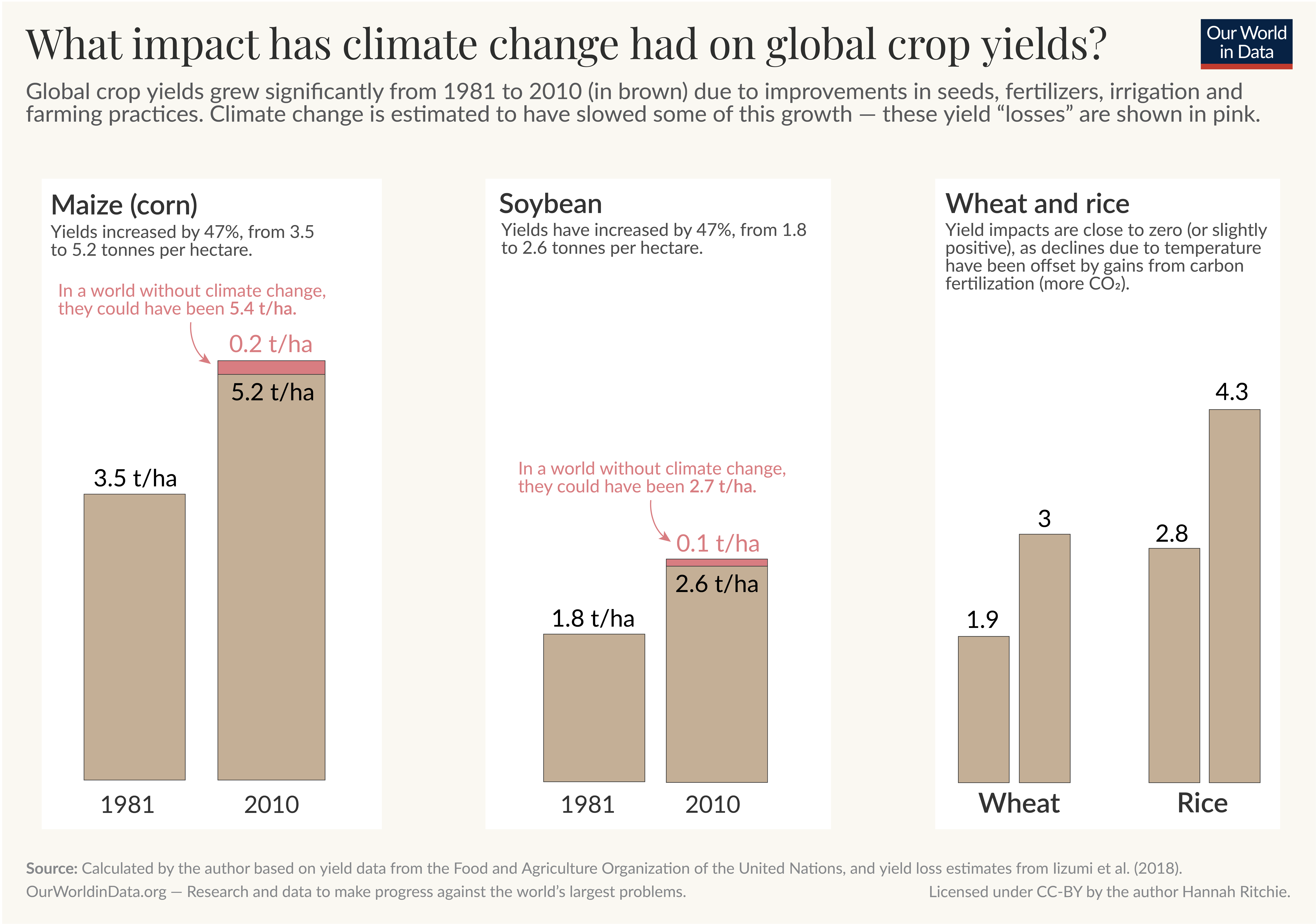
Overall, climate change has probably already suppressed crop yields of key crops like maize at a global level (with varying patterns across regions). But we’ve also seen massive improvements in yields thanks to non-climate developments in agricultural technologies.
This is crucial to keep in mind when we look at the future impacts of climate change. It will put increasing pressure on many crops, but we are not helpless in adapting and enhancing our food systems to deal with it.
Acknowledgements
Many thanks to Max Roser and Edouard Mathieu for their comments on this article, and to Jonas Jägermeyr for invaluable suggestions and feedback on this series of work.
Citation
Hannah Ritchie (2024) - “Crop yields have increased dramatically in recent decades, but crops like maize would have improved more without climate change” Published online at OurWorldinData.org. Retrieved from: 'https://ourworldindata.org/crop-yields-climate-impact'




